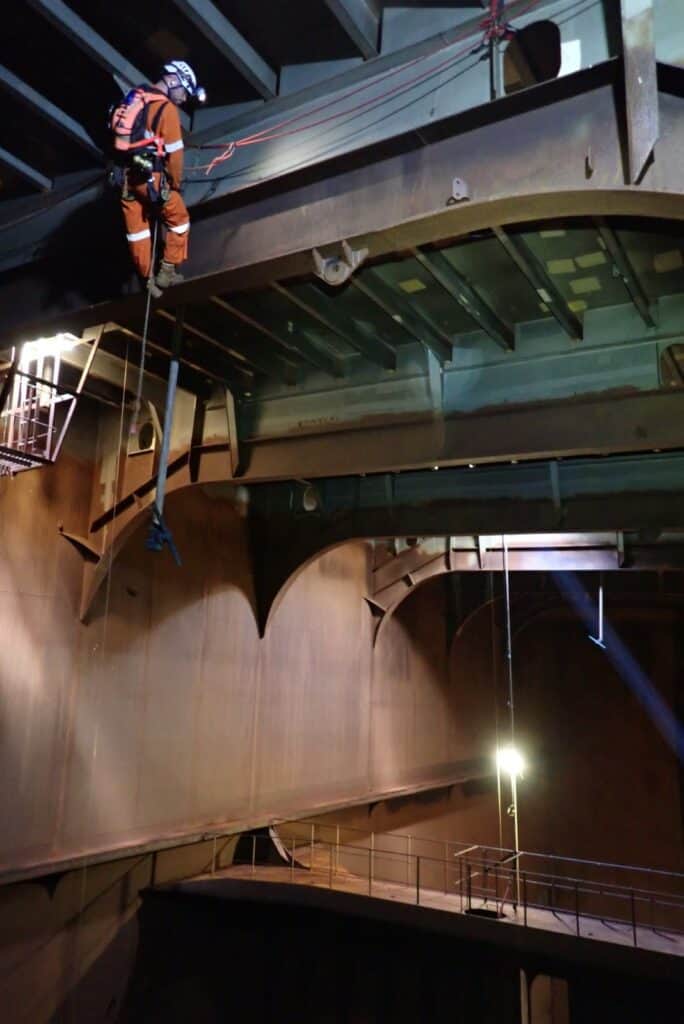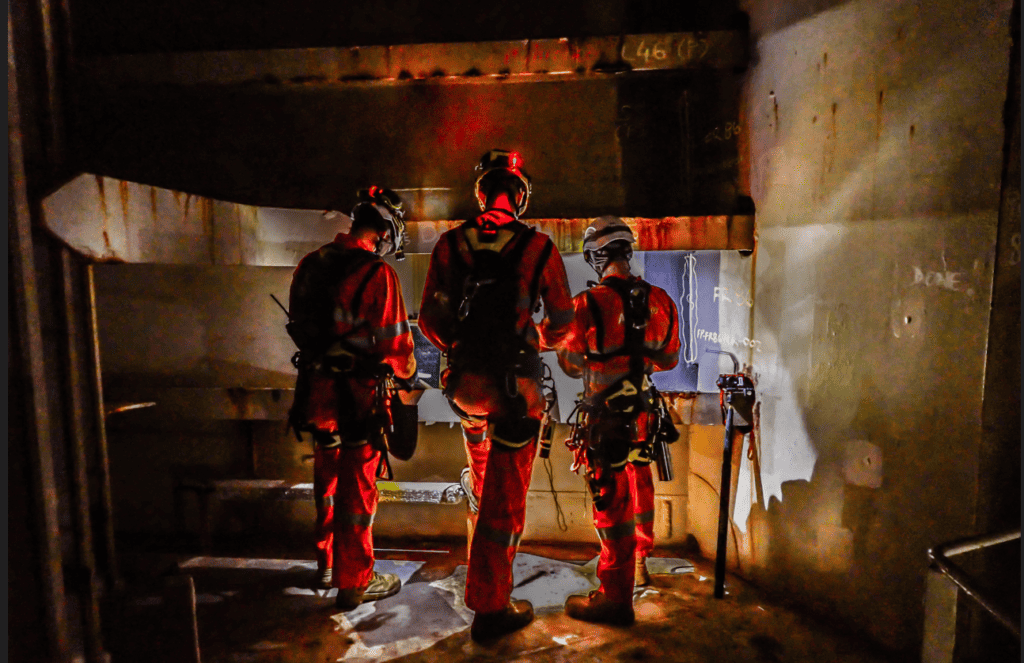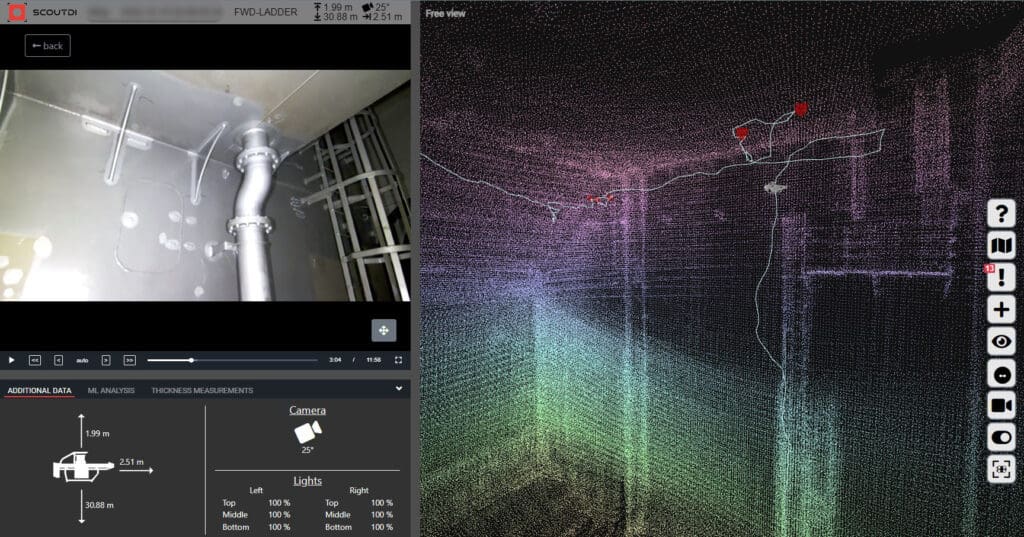Case Study
APPLUS+ inspects cargo tank using Scout 137 Drone System
Unlimited flight-time provides optimum working conditions and maximizes safety, efficiency and data quality.
Executive summary
APPLUS+ has performed visual inspection of a very large (> 20 000 m3) cargo tank for a global oil & gas major, using the Scout 137 Drone System from ScoutDI. Applus were the first in Australia to use this equipment and have it approved under the Lloyds Register ‘Remote Inspection Techniques’ (RIT’s) certification scheme. The possibilities that Applus can offer their clients for future confined space inspections are greatly improved, whilst the unlimited flight time of the Scout 137 Drone is found indispensable.

The Scout 137 has a 64-beam 3D LiDAR with a 90° opening angle and ~100 m range. This enables rock-steady positioning, reliable navigation and accurately location-tagged inspection data.
Safety benefits
Traditional inspections of a cargo tank of this size (> 20 000 m3) normally require 4-5 rope access technicians, with additional support personnel. They will be working at height, under deck for 4-5 days. These are exhausting conditions, with little ambient light and poor air quality.
This visual drone inspection was done flying the Scout 137 Drone System from the tank floor. The entire inspection job was completed in 1 shift and a team of 4 people were involved.
Based on findings from the visual inspection, subsequent NDT was performed via rope access with very targeted and reduced scope. The exposure of humans working at heights and other dangerous conditions is thus greatly reduced using confined-space inspection drone systems.
The Scout 137 Drone System from ScoutDI has a tether system that provides unlimited flight-time. The constant interruptions and stress related to frequent battery changes were eliminated by this and allowed more focus on the job.
Efficiency and operational benefits
Using drone inspection obviously reduces or eliminates personnel exposure, but also reduces production downtime, personnel transport and related logistics. Beyond the data acquisition, having well-planned continuous video footage makes data verification and analysis easier and faster.
High-speed internet being available at the inspection site added the benefit of live streaming via the Scout Portal. This allows off-site stakeholders to take part in the inspection remotely in real-time. Coverage approval, flight patterns and other immediate action can be planned while the crew is on-site, eliminating the need for costly and time-consuming revisits.
Data coverage and data quality
Having unlimited flight time allows the pilot to focus entirely on the job and the resulting data.

The traditional alternative to drone inspection is manual inspection via rope access. This is risky and exhausting work, requiring qualified teams of technicians to expose themselves to hazardous environments for hours at the time. It is also expensive, time consuming and prone to return less consistent data with less coverage.
About APPLUS+
APPLUS+ has over 25 000 employees in more than 70 countries and is a global leader in testing, inspection, and certification. They offer solutions ranging from asset integrity management to statutory compliance-based inspections.
Applus focuses on possessing the latest knowledge of regulatory requirements and has a strong emphasis on technological development, digitalization, and innovation. They own and use a range of inspection robots, including ROVs (Remotely Operated Vehicle), indoor- and outdoor drones.
In the context of this case study, Applus is on a long-term multi-faceted inspection, testing and certification contract for onshore and offshore assets with a global Oil & Gas major and using the Scout 137 Drone System as a crucial tool.
Description of the drone inspection
The inspection target in this case, is a > 20 000 m3 cargo tank on a very large floating asset, situated offshore Australia. The inspection crew full total was 4 people: The Applus pilot and co-pilot, an Applus Marine Inspector and the Class Surveyor.
The inspection was flown VLOS, i.e. the pilot having visual line of sight to the drone. The inspection crew accessed the floor via the internal access system and remained there throughout the inspection.
The visual part of the inspection was performed entirely using the Scout 137 Drone System, assessing general structural integrity and with a specific focus on welds. Additionally, even though the highly reflective coating appeared as new to the eye, attention was routinely given to assess the coating and look for corrosion. Bracket toes were also inspected for corrosion and cracks.
Scout 137 Drone traversing under deck area. A drone can quickly reach high altitudes and cover large surfaces very efficiently. Although the preparation time for drone inspections is comparable to other methods, there are great benefits in terms of safety and efficiency, data coverage and -availability.

The flight was planned on the spot, based on general visual assessments of the tank. The scope of the inspection was basically 100% coverage of everything, every plate and every corner, every weld and bracket. However, some short-term planning related to the tether was necessary due to the number of features mounted on bulkheads and the upper deck. The extent of such features was such that it would have hindered also untethered drones, with other “hookable” features.
Unlimited flight-time
The Scout 137 was flown for about 1 hour 10 mins continuously, completing the entire inspection job in 1 shift. For vessels this big, it is a great advantage to complete in one shift since entry and exit is a considerable and time-consuming effort.
The crew reported that being able to perform long flight sessions without interruptions eased pilot stress tremendously. Even if changes can be done quickly and an unlimited number of batteries were available; battery changes and extra flying back and forth would extend the job into multiple shifts while also putting more stress on the crew.
3D LiDAR sensor
Another feature that was found extra beneficial here, was the 3D LiDAR sensor of the Scout 137 Drone. With no GPS present, relying on optical sensors or cameras for navigation and stability, would be infeasible due to the size of the volume and lack of light. The current Scout 137 Drone utilizes a 64-beam LiDAR sensor with an approximate range of 100 m, which provided ample stability and precision for the location-tagged data.

POI photo from the inspection, downloaded from the Scout Portal. The drone was 55cm away from the wall when the photo was taken. It is also 17 m above the floor, a position which the drone can reach in a couple of seconds. The 4K resolution allows extensive zooming.
Upon completion, the visual inspection had identified 6 findings of some similarity with regards to crack indications and coating defects.
With a scope based on the visual inspection, NDT with rope access was then organized to further assess the findings from the drone inspection. The scope of this part of the job was drastically reduced because it could be determined from the drone data.
Surveyor attendance
A class surveyor was physically present throughout the visual inspection and follow-up NDT work. The surveyor was located together with the inspection team, co-watching the Scout 137 video feed with the pilot and crew. The surveyor was generally pleased with the data quality and level of coverage and detail achieved with the ScoutDI system.
APPLUS+ are currently live streaming data from other remotely deployed tools and exploring StarLink satellite data as an option to facilitate internet connections widely. This opens the possibility to further reduce the need for bringing resources onboard. Subject matter experts (SMEs) and class surveyors are able to just view live stream data whilst remaining off-site. The Scout 137 Drone System provides live streaming of Full HD video data via the Scout Portal, ScoutDI’s powerful cloud-based inspection data management service.
This implies that remote monitoring is a future possibility for Applus and their clients. It represents a strategic turn that will increase safety, save cost and time, reduce travel and lend great flexibility to their operations. Remote approval of work scopes, while also securing sufficient data coverage and avoiding site re-visits are obvious benefits to reap when new technology is aligned with strict safety regulations.

Snapshot from the Scout Portal, showing part of the upper deck being inspected.
Conclusion
APPLUS+ performed visual inspection with drone, of a > 20 000 m3 cargo tank on a very large vessel. The entire visual inspection took Just one shift instead of the “normal” 4-5 shifts.
Direct comparison was done with a more conventional confined space inspection drone, in which the Scout 137 performed overall better. Firstly, the unlimited flight time of the Scout 137 Drone System proved invaluable, moving focus over to the inspection part of the job. This removed stress related to battery changes and reduced completion time considerably. Continuous, focused flight for prolonged periods allowed more thorough inspection and complete coverage, which was required for this assignment.
Secondly, the Scout 137’s 3D LiDAR-based navigation system for spatial awareness and location-tagging of data was a better solution over the alternative system.
Given an acceptance to utilize new technology solutions and the right changes in regulation, Applus may be able to rely on live remote inspection streaming and reduce the need for highly qualified specialist surveyors to be physically present on-site.
Would you like to know more about the Scout 137 Drone System?
Are you looking for drone-based inspection technology for confined industrial spaces? Submit the form below to get in touch with us and we'll help you look at your options 👍
Learn More
Scout 137 Drone →
The Scout 137 Drone System has been specifically designed to give you control, coverage, and situational awareness for your confined space inspection activities.
Scout Portal →
The Scout Portal is our powerful cloud-based tool for inspection data management, review, analysis and reporting.